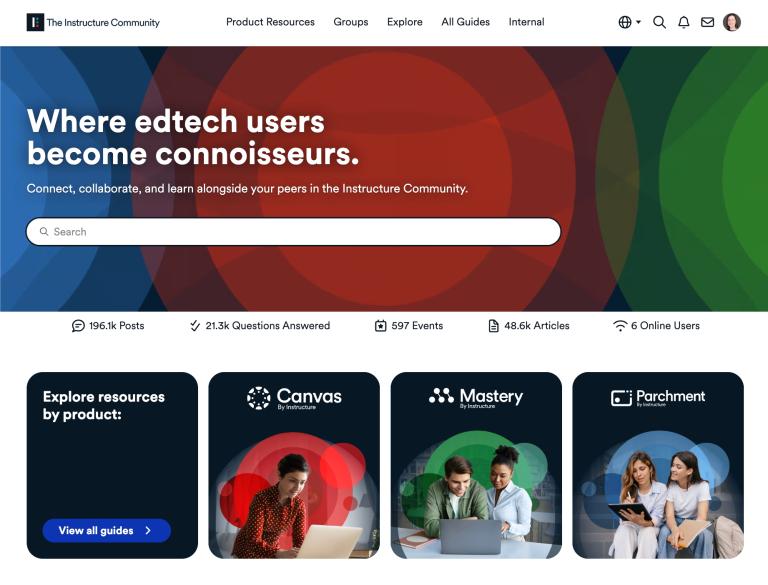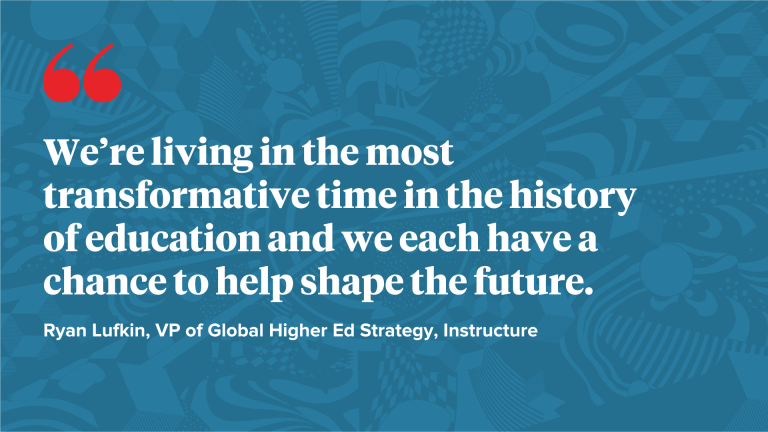Understanding AI basics will help lay the groundwork for your institution to strategically harness the power of AI on your campus. Read on for 5 in-depth tips to get you started on the path to comprehensive AI strategy and deployment.
1: Get Familiar with the Terms and Definitions
In order to embark on the journey of harnessing the positive aspects of AI in education, one must understand the basic definitions of the terms that are often included in this conversation.
Generative AI is a type of artificial intelligence technology that can produce various types of content including text, imagery, and audio. Though the technology was first introduced in the 1960s in chatbots, only recently has the simplicity of new user interfaces for creating high-quality text, graphics, and videos in a matter of seconds, opened the tools to every-day users.
Large Language Models use a neural network with billions of parameters, trained on large quantities of text from the internet to deliver human-like language results. Large language models demonstrate considerable general knowledge about the world, and are able to "memorize" a great quantity of facts during training.
OpenAI is a non-profit research organization dedicated to developing and applying artificial intelligence (AI) for the benefit of humanity as a whole. Their code, also called OpenAI, is an open source solution that developers can use to power tools for text, code, and image generation.
ChatGPT is an AI chatbot released by OpenAI that delivers human-like, detailed answers to inquiries, anything from drafting a real estate contract to creating detailed code, to the public on November 30, 2022 and quickly amassed one million subscribers just a week after its launch.
AI Chatbots are computer programs that use artificial intelligence (AI) and natural language processing (NLP) to understand questions typed in by an end-user and automate responses to them, simulating a human conversation.
2: Understand the “Why” Behind Each AI Use Case
How can AI facilitate a better assignment and assessment experience?
Assignments and assessments in college courses serve multiple purposes, including facilitating learning, developing and measuring skills, assessing student performance, providing feedback, and preparing students for their academic and professional journeys. Helping students understand the "why" behind these activities can help them engage more effectively with the course material, reduce the likelihood of turning to shortcuts, and make the most of their educational opportunities.
- Knowledge acquisition: Assignments and assessments provide opportunities for students to engage actively with the course material, apply their knowledge, and deepen their understanding. By completing assignments, students can explore concepts, theories, and ideas in a practical way, reinforcing their learning and gaining new insights.
- Skill development: Assignments and assessments help develop a range of skills essential for academic success and beyond. These may include critical thinking, problem-solving, research skills, written and oral communication, analysis, synthesis, and creativity. By engaging with different types of assignments and assessments, students can strengthen these skills and become more proficient in their field of study.
- Demonstration of mastery: Assignments and assessments allow students to demonstrate their mastery of the course content and skills. They provide an opportunity for students to showcase their understanding and apply what they have learned. Through assessments, instructors can gauge students' progress and determine if they have achieved the learning objectives and outcomes of the course.
- Preparation for real-world challenges: These course activities often simulate real-world scenarios, enabling students to develop practical skills and readiness for their future careers. These tasks can mirror the challenges students may encounter in their professional lives, preparing them for the expectations and demands of their chosen field.
3: Create Ethical AI Usage Guidelines for Students & Educators
AI technology is set to have broad social and environmental impacts. Ethical guidelines encourage students to assess and mitigate the potential negative consequences of their AI projects on society and the environment. As future professionals, students need to understand their ethical responsibilities in the AI domain. Ethical guidelines provide a framework for students to develop a professional mindset that prioritizes ethical conduct, integrity, and accountability.
4: Offer Professional Development and Training around AI for Educators
Our educators' knowledge of AI tools and their usage, both positive and negative, vary broadly. PD and training around AI for educators is essential for keeping them up-to-date with technological advancements, integrating AI into pedagogy, promoting ethical and responsible AI use, fostering data literacy and digital citizenship, addressing equity and inclusion, and fostering collaboration and innovation. Equipping educators with AI knowledge and skills ensures that they can effectively prepare students for careers in the digital age and empower them to navigate the opportunities and challenges presented by AI technology.
Delivering professional development (PD) and training around AI for educators is important for several reasons:
- Keeping Pace with Technological Advancements: AI is rapidly evolving, and educators need to stay updated with the latest advancements to effectively incorporate AI into their teaching practices. PD and training ensure that educators are equipped with the necessary knowledge and skills to understand and utilize AI technologies appropriately in the classroom.
- Integrating AI into Pedagogy: AI has the potential to transform educational practices and enhance student learning experiences. Educators need PD and training to understand how AI can be integrated into their pedagogical approaches, curriculum design, and assessment strategies. This empowers them to leverage AI tools and platforms effectively to support student engagement, personalized learning, and collaborative problem-solving.
- Ethical and Responsible AI Use: AI raises ethical considerations, such as bias, privacy, and transparency. Educators need PD and training to navigate these ethical challenges and guide students in using AI ethically and responsibly. By understanding the implications of AI, educators can promote critical thinking and ethical decision-making among students while using AI tools and resources.
- Addressing Equity and Inclusion: AI systems can perpetuate biases and inequalities if not properly understood and addressed. PD and training around AI for educators emphasize the importance of addressing bias, promoting inclusivity, and ensuring equitable access to AI resources. Educators can develop strategies to mitigate bias and ensure that AI technologies are used in a way that benefits all students, regardless of their backgrounds.
5: Develop a Proactive vs Punitive Approach to AI Detection
Developing a proactive approach to AI detection, rather than a punitive one, is important for several reasons:
- Ethical Considerations: Proactive AI detection allows organizations to anticipate and address ethical challenges, such as bias, privacy concerns, or discriminatory outcomes. By actively monitoring and detecting potential ethical issues, organizations can take corrective actions, ensure fairness, transparency, and accountability. Ideally it eliminates the chance of falsely accusing students by shifting the focus away from cheating-detection and towards ethical usage.
- User Trust and Confidence: Proactive detection helps establish and maintain user trust and confidence in AI systems. When organizations demonstrate their commitment to detecting and addressing issues, users feel reassured that their concerns are being taken seriously. This builds trust in AI technologies and increases user confidence in their reliability and fairness, fostering positive user experiences and long-term engagement.
- Organizational Reputation and Compliance: Proactively addressing AI issues reflects an organization's commitment to integrity and compliance. By actively detecting and resolving problems, organizations can safeguard their reputation, demonstrate accountability, and meet legal and regulatory requirements. This proactive approach minimizes the risk of negative publicity, legal consequences, and loss of public trust.
We’re living in the most transformative time in the history of education and we each have a chance to help shape the future. Learn more about Instructure’s ethical AI strategy approach here and the history of AI here.
Related Content
 inst-3step.jpg
inst-3step.jpgBlogs
 community-homepage.jpg
community-homepage.jpgBlogs
 kim-classroom.jpg
kim-classroom.jpgBlogs
